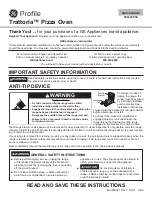
3
Canning Basics
Introduction
The key to successful canning is to understand the acidity and spoilage factor of the foods you wish to can, as well as the acceptable
canning methods to process those foods. There are invisible microorganisms present all around us. Fruits, vegetables, and meat
contain these microorganisms naturally; yet they are not a problem unless food is left to sit for extended periods of time, causing food
spoilage. This is nature’s way of telling us when food is no longer fit to eat.
There are four basic agents of food spoilage: enzymes, mold, yeast, and bacteria. Canning interrupts the natural spoilage cycle so food
can be preserved safely. Molds, yeast, and enzymes are destroyed at temperatures below 212°F, the temperature at which water boils
(except in mountainous regions). Therefore, the boiling water method is sufficient to destroy those agents. Foods naturally high in acid
and acidified foods with a pH of 4.6 or less may be safely processed using the boiling water method.
However, bacteria are not as easily destroyed and thrive on low-acid foods in the absence of air. The bacteria
Clostridium botulinum
produces a spore that makes a poisonous toxin, which causes botulism. This spore is not destroyed at 212°F. According to the USDA,
pressure canning is the only safe method of processing low-acid foods (vegetables, meats, poultry, fish, and seafood).
In pressure canning, some of the water in the pressure canner is converted to steam, which creates pressure within the canner. As the
pressure increases, so does the temperature: 5 pounds pressure reaches 228°F; 10 pounds pressure reaches 240°F; 15 pounds pressure
reaches 250°F. This pressurized heat destroys the potentially harmful bacterial spores. As the jars cool after processing, a vacuum is
formed, sealing the food within and preventing any new microorganisms from entering and spoiling the food.
Before Beginning
Selecting Jars
Glass home canning jars, often referred to as Mason jars, are made of heat-tempered glass for durability and reuse. These are the
only jars recommended for safe home canning. They are available in several standard sizes (half-pint, pint, and quart jars) and will
withstand the heat of a pressure canner. The diameter of Mason jars may vary from one manufacturer to another.
Before filling your Mason jars, test load your canner. A canning rack must be placed on the bottom of your canner to prevent jar
breakage. The jars may touch and it is not necessary to use a rack between the layers of jars. It may be necessary to double-deck the
pint and half-pint jars to reach the maximum load capacity of your canner. To double-deck, stagger the jars by placing one jar on top of
two. However, if using the boiling water method, do not double-deck the jars.
Canning Lids and Bands
The two-piece vacuum cap is the recommended closure for home canning. It consists of a flat metal lid with a sealing compound on
the outer edge and a separate metal screw band that secures the lid during processing. The flat lid is for one use only while the bands
can be used repeatedly if they remain in good condition. Always prepare lids and bands according to the manufacturer’s instructions.
Measuring Headspace
Headspace is the air space between the top of the food or its liquid and the lid. Leaving too much headspace can result in
underprocessing because it may take too long to release the air from the jar. Leaving too little headspace will trap food between the jar
and the lid, resulting in an inadequate seal.
As a general rule, allow ½-inch headspace for fruits and tomatoes and 1-inch headspace for vegetables, meats, poultry, and seafood.
All current and tested canning recipes will indicate the amount of headspace necessary for the food being canned.
Removing Air Bubbles
After the food has been packed in the Mason jars, any air bubbles must be removed. Trapped air bubbles may rise to the top during
processing, resulting in too much headspace. Work quickly to remove the air bubbles that have become trapped between pieces of food
by moving a clean, nonmetallic spatula around the jar between the food and the side of the jar.
Preparing Jar Rims and Adjusting Lids
Immediately wipe the jar rims with a clean, damp cloth to remove any residue. Any food particles, such as seeds, grease, or syrup,
on the rim of the jar may prevent the jar from sealing. Place the flat lid on the rim of the jar, making sure the sealing compound is
touching the glass. Position a band over the lid and, using your fingertips, screw it onto the jar just until resistance is met. Do not
overtighten as the air must release from the jars during processing and cooling.
After Processing
Cooling Jars
After processing, remove the jars from the canner and place them on a dry towel on the countertop away from drafts. Leave 1 to
2 inches of space between the jars to allow for even cooling. Do not invert the jars or cover them with a cloth. Allow jars to cool
naturally for 12 to 24 hours before checking the seals.




































